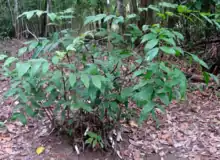Desmoncus polyacanthos
Desmoncus polyacanthos, the jacitara palm,[4] is a spiny, climbing palm native to the southern Caribbean and tropical South America. Stems grow clustered together, and are 2–12 m long and 0.5–2 cm in diameter. Petioles, rachis, cirrus and peduncular bracts are covered with short, curved spines.[5] Two varieties are recognised: D. polyacanthos var. polyacanthos[2] and D. polyacanthos var. prunifer (Poepp. ex Mart.) A.J.Hend.[3]
| Desmoncus polyacanthos | |
|---|---|
 | |
| Scientific classification | |
| Kingdom: | Plantae |
| Clade: | Tracheophytes |
| Clade: | Angiosperms |
| Clade: | Monocots |
| Clade: | Commelinids |
| Order: | Arecales |
| Family: | Arecaceae |
| Genus: | Desmoncus |
| Species: | D. polyacanthos |
| Binomial name | |
| Desmoncus polyacanthos | |
| Synonyms | |
|
Atitara polyacantha (Mart.) Kuntze[1]
Desmoncus macroacanthos Mart.
Desmoncus prunifer Poepp. ex Mart. | |
Desmoncus polyacanthos is found in Colombia, Venezuela, Saint Vincent and the Grenadines, Trinidad and Tobago, Guyana, Suriname, French Guiana, Brazil, Bolivia, Ecuador and Peru.[1][5] The stems are used for baskets and sieves.[5]
References
- "Desmoncus polyacanthos". Royal Botanic Gardens, Kew: World Checklist of Selected Plant Families. Archived from the original on 2013-08-02. Retrieved 2007-10-03.
- "Desmoncus polyacanthos var. polyacanthos". Royal Botanic Gardens, Kew: World Checklist of Selected Plant Families. Retrieved 2007-10-03.
- "Desmoncus polyacanthos var. prunifer". Royal Botanic Gardens, Kew: World Checklist of Selected Plant Families. Retrieved 2007-10-03.
- "Properties of an Amazonian vegetable fiber as a potential reinforcing material". Retrieved 2017-11-18.
- Henderson, Andrew; Gloria Galeano; Rodrigo Bernal (1995). Field Guide to the Palms of the Americas. Princeton, New Jersey: Princeton University Press. ISBN 0-691-08537-4.